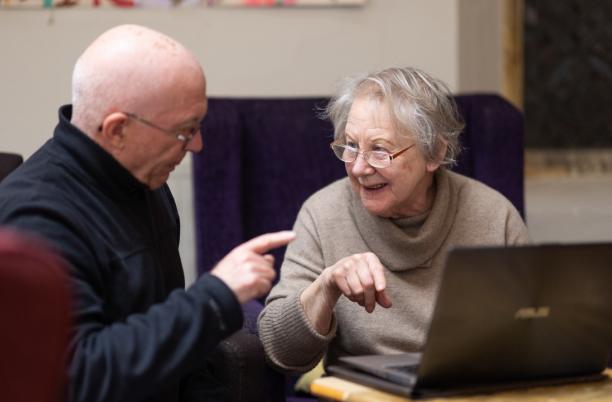
Inclusive Virtual Services

Find out how Willowbrook hospice is working to make sure its online services are inclusive.
Title
About this innovation example
Project and outcomes
Project overview
During the COVID-19 pandemic, Willowbrook hospice set up a virtual service to replace its face-to-face day hospice and outreach services. With a remodelled service, the outreach team is now delivering a range of wellness services both in person and via an online platform. Some activities, such as guided meditation, use a hybrid approach - taking place in person and being live-streamed.
Willowbrook is also using virtual reality to support patients at home, helping them to re-experience holidays and see the outside world. The team has put together a virtual walk-around of the local area.
Outcomes
Using digital technology has enabled Willowbrook to expand the reach of their services. In the past, when all outreach and day services were in-person, people would stop accessing the service once they were too unwell to come to the hospice, or once they had been discharged from in-person services. But now people can access the virtual platform whenever they need, right up until their death.
Feedback on this hybrid model of care is good and patients want it to continue. The virtual relaxation sessions and Arts and Crafts Club have been particularly popular. Other services include wellness groups, symptom control and holistic support at home.
Some patients who are in a care home have told the hospice team that even though they have staff to care for them, they are alone for periods of time. Using the virtual platform has helped them feel less isolated.
Housebound patients report that using the virtual reality tools help them feel as if they are getting ‘out and about’. There is evidence that it is helping reduce anxiety and pain.

“You’re the voice I heard every week…I used to relax during your sessions too”
Carer
Facilitators, challenges and advice
Key facilitators
The hospice staff work to identify and overcome any barriers to accessing the virtual services. They run digital awareness sessions for patients and carers, which cover the full range of digital technology people might have in their home. For example, the team might talk to people about:
- How to connect to WiFi
- Sending emails
- Voice calls and video calls
- Using a tablet
- Cyber security
- Smart TVs
- Doorbell technology
They visit people at home and also run a digital drop-in session, where people can bring their device in to the hospice to get support.
It’s really helpful to have peer support and encouragement. Some older people think they are too old for technology – but they will change their mind once they see someone who is the same age as them accessing the online services!
Challenges
Delivering the online services was initially quite daunting for staff. It felt quite different to working with face-to-face groups as there are more distractions for people at home and staff were conscious of keeping people’s focus. They have had to adapt their techniques for the online environment.
There is no escaping from WiFi and connectivity problems – both in the hospice and at home! It’s important to provide people with the best possible service and make things as easy as possible. When you are unwell, you don’t necessarily have the energy to reconnect a router or try a different way to log in to a call.
The team are aware that some patients at home are too ill to access online services at all.
Tips and advice
Don’t let fear get the better of you when you’re trying something new! Prepare as much as you can and practice your online sessions in advance.
Make sure you’ve got really good WiFi and all the technology you need to be able to handle what you want to do.
It’s natural for human beings to resist change. Work on building their confidence and break down barriers. You might have to carry your own momentum and energy while others catch up. Be confident and enthusiastic.
Future development
The team would like to start a digital library, so they can loan equipment to those who need it. They feel that the risk of not getting equipment back is offset by the benefits of making the service more inclusive.
They are also aiming to install Smart TVs in every in-patient room. This would mean patients can access the virtual platform and take part in the online relaxation sessions, for example.
Image: courtesy of In-Press Photography via The Centre for Ageing Better

